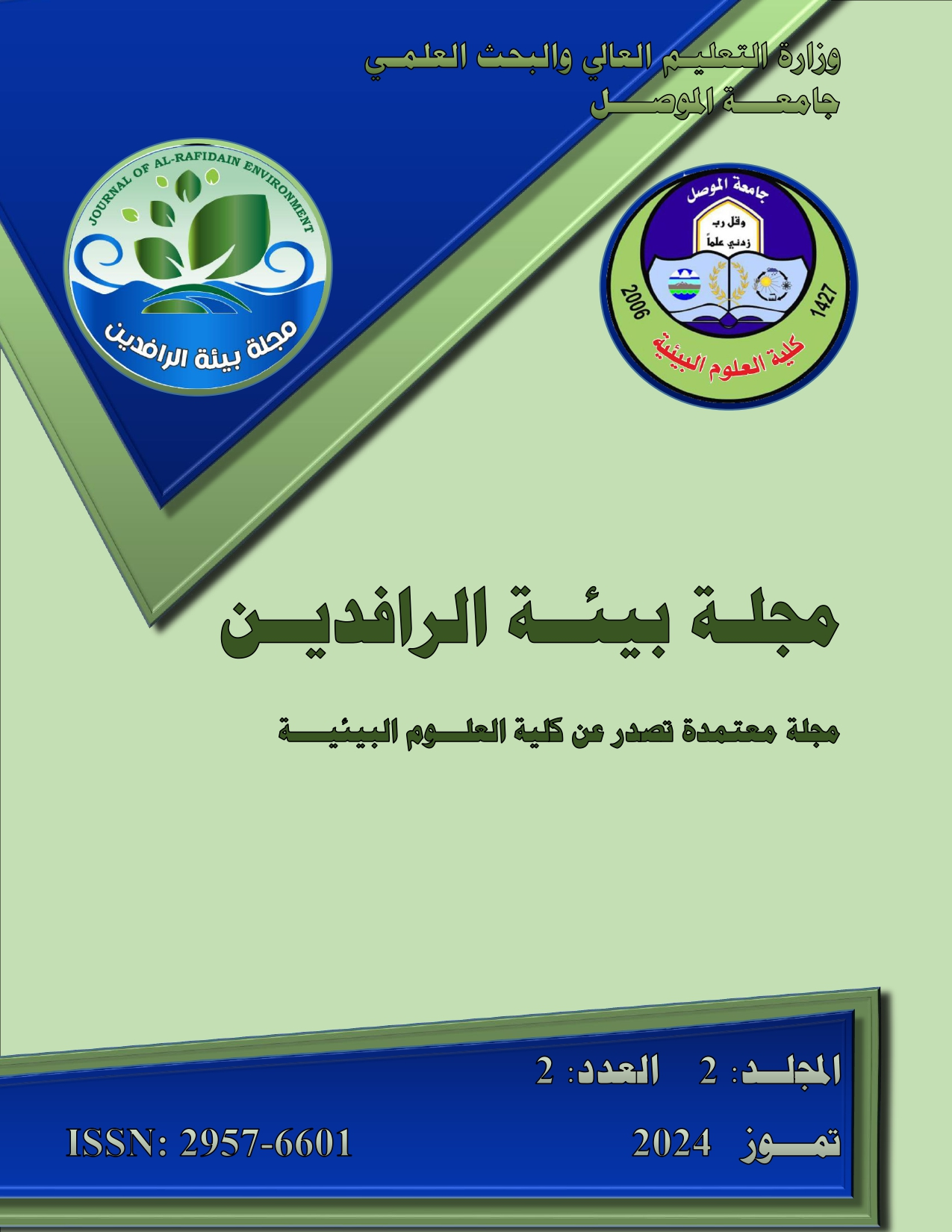Qualitative Assessment Of Some Water Wells (Baaj, Tal Afar, Hamdania and Hammam Al-alil) Within Nineveh Govemorate and Their Suitability for Drinking and Irrigation

Published
Oct 6, 2025Pages
12-30Abstract
The current study involves the qualitative evaluation of water wells (Baaj, Tal Afar, Hamdania and Hammam Al-alil) within Nineveh to assess their suitability for drinking and irrigation during October in the year 2023. The analysis encompasses physical and chemical parameters, including cations (K+, Na+, Ca+2, Mg+2), anions (Cl-, SO4-, PO4-2, HCO3-), TDS, pH, electrical conductivity, total hardness, as well as the percentage of sodium, sodium absorption ratio, and heavy metals (lead, iron, copper, zinc, cobalt). Lab tests have shown that this water is not fit for drinking and irrigation purposes by specifications that have been adopted. As well as the water wells was studied with high concentrations of sulphate, which reduces agricultural and human use:
The results revealed that concentrations of heavy metals (copper, iron, zinc) were within the permissible limits, whereas concentrations of lead and cobalt exceeded the allowable limits for drinking water. Electrical conductivity in the water wells of Hamdania and Hammam Al-alil fell within the allowable limits, whereas those in Baaj and Tal Afar exceeded the permissible limits. The pH levels ranged between 6.70 and 7.58, remaining within the allowable limits. The calcium concentration in the water wells of Hamdania and Hammam Al-alil was within the permitted range, but in Baaj and Tal Afar, it exceeded the allowable limits. The magnesium concentration in the water wells of Hamdania, Hammam Al-alil, Tal Afar, and Baaj exceeded the allowable limits. Potassium concentrations in the water wells of Hamdania, Hammam Al-alil, Tal Afar, and Baaj were within the permissible limits. Sodium concentrations in the water wells of Tal Afar and Hammam Al-alil were within allowable limits, whereas in Baaj and Hamdania, they exceeded the permissible levels. The chloride concentration in water wells in Baaj, Tal Afar, Hammam, and Hammam Al-alil fell within allowable limits. However, the sulfate concentration in water wells in Baaj, Tal Afar, Hammam, and Hammam Al-alil exceeded the allowable limits. Phosphate concentrations in water wells in Baaj, Tal Afar, Hamdania, and Hammam Al-alil also exceeded the allowable limits. The bicarbonate concentration (183-280 mg/l) falls within the allowable limits.
References
- Allison, L. E. ; Bernstien, l. ; bower, C. A. (1954). Agriculture Handbook, No. 60.
- Al-Layla, M. A. ; Ahmmad, S. ; Middlebrooks, E. J. (1977). Water Supply Engineering Design. Ann Arbor Science publishers lnc., USA, p.184.
- Ali, A., Iqbal, M., and Waheed, A. (2021). Groundwater quality assessment near Nullah Lai stream of Pakistan. Central Asian Journal of Environmental Science and Technology Innovation, 2(2), 45-51.
- Al-Hayani, Abdul Sattar Jubeir. (2009). Groundwater Assessment of Some Wells of Al-Khafajiya Village in Anbar Governorate. Anbar University Journal of Science and Finance, Vol. 3, No. 2.
- Al-Hayali, Afaf Khalil Abdullah. (2010). Study of the quality of well water in the city of Mosul and its suburbs and its suitability for drinking and irrigation. Journal of Education and Science, Volume 23, Issue 3, pp. 67-48.
- Adib, Hadeer Ghazi Muhammad. (1988). Synthetic and stratified, the city of Mosul, right side. Unpublished Master's Thesis, College of Science, University of Mosul, p.168.
- Abdel Moneim, Essam Muhammad, Ahmed bin Ibrahim Al-Turki. (2012). Heavy elements: their sources and damage to the environment. Qassim University, p. 6.
- Chapelle, F.H. (2004). Geochemistry of groundwater. In Holland, H.D. and Turkian, K.K. Treaties of Geochemistry. Surface and groundwater, weathering and soils. p. 425-449.
- Donnen, U. (1954). A Dignosis and improvement of saline water permeability of soil. handbook, washonton.
- Davis ; Dewiest. (1966). Hydrogeology. John Willy and Sons, New York, p. 463.
- Gazzi, M. F., and Beg, A. A. F. (2022). Assessment of groundwater quality for irrigation purposes using the irrigation water quality index (IWQI)/Al Rashidiya area-A Case Study. Journal of College of Education, 3(1813-0380).
- Gabr, M. E., Soussa, H., and Fattouh, E. (2021). Groundwater quality evaluation for drinking and irrigation uses in dayrout city upper egypt. Ain Shams Engineering Journal, 12(1), 327-340.
- Ibrahim, Ahmed Khalil. (2010). Study of groundwater quality for selected areas of Nineveh Governorate. Master Thesis, Faculty of Engineering, Department of Civil Engineering, University of Tikrit.
- Manhan, S.E. (2004), Enviromental chemistry, CRC Press, 8th ed., Washington DC USA. P.763.
- Muhammad, A. S. (2021). Environmental assessment of drinking water characteristics in Al-Muthanna governorate. Misan Journal of Academic Studies.
- Mohammad, E. A., Ektifa Taha, A., Fatma Adnan, S., and Rania Haithem, S. (2020). Study of qualitative properties of groundwater and its suitability for different uses in the Eastern of the Al-Dour city/Salahaldin/Iraq. Tikrit Journal of Pure Science, 25, 2.
- Ministry of Planning, (1992). Draft Standard Specification No. 324. Central Organization for Standardization and Quality Control, Baghdad.
- Provinces, Joseph Francis Matthew. (2000). Determining the best aquifer in the Hamdaniya area using electrical exploration. Master's thesis / College of Science / University of Mosul / Mosul / Iraq.
- Raghunath, H. M. (1988). Ground Water, 2nd ed., Wily Eastern limited, New Delhi, p. 563.
- Sawyer, G. N. ; McCarty, P. N. (1978). Chemistry for Environmental Engineering, 3rd ed., McGraw-Hill, U.S.A, p. 532.
- Taylor, S. A. ; Asheroof, G. L. (1972). Physical edaphology.
- Todd, D. K. (1980). Ground Water Hydrology. 2nd ed., John Willy and Sons lnc. New York, p. 336.
- Hamad, J.R.J.; Yaacob, W.Z.; Omran, A. (2021). Quality assessment of groundwater resources in the city of Al-Marj. Libya. J. Processes, 9(1), 154.
- Varshney, R. S. ; Gupta, S. C., R. L. (1983). Theory and Design of lrrigation. Structures, Vol. 1, lndia.
- WHO. (1996). Guidelines for Drinking Water Quality. Geneva Switzerland, 2nd ed., Vol. 21., p.70.
Identifiers
Download this PDF file
Statistics
Copyright and Licensing

This work is licensed under a Creative Commons Attribution-NonCommercial 4.0 International License.